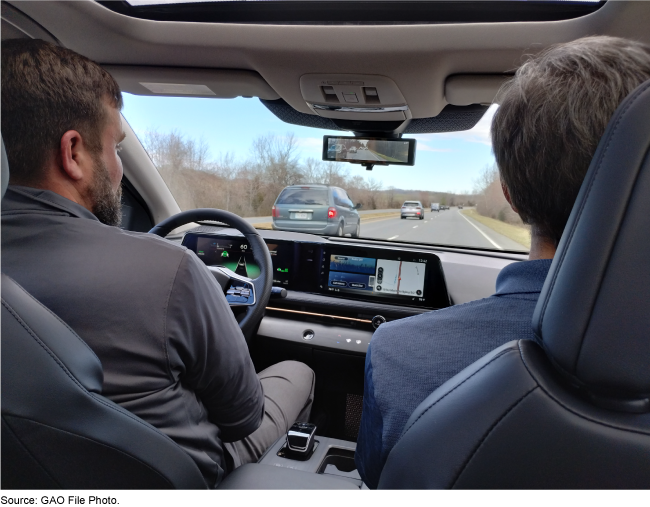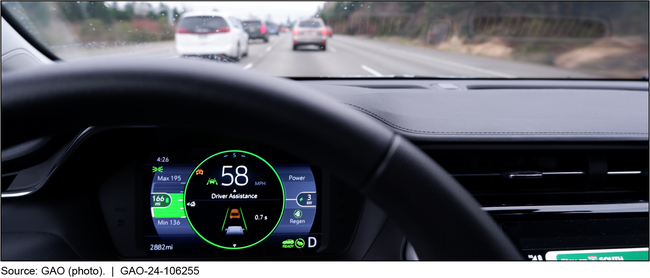Driver Assistance Technologies: NHTSA Should Take Action to Enhance Consumer Understanding of Capabilities and Limitations
Fast Facts
Driver assistance technologies are increasingly included in new vehicles. But drivers who don't understand these technologies may increase their risk of accidents by turning off safety features or over-relying on convenience features.
The New Car Assessment Program is one way the National Highway Traffic Safety Administration educates drivers on vehicle technology. NHTSA's proposed updates to the program could help people better understand these technologies, but the updates are still in progress after more than a decade.
Our recommendations include communicating information about NHTSA's progress and delays in updating the program.

Highlights
What GAO Found
New vehicles are increasingly equipped with driver assistance technologies designed to prevent or mitigate crashes (crash avoidance technologies) and support the driving task (driver support systems). According to interviewed stakeholders and research GAO reviewed, when drivers have a realistic understanding of their vehicles' driver assistance technologies, they are more likely to use them as intended. There is some evidence, however, that consumers do not always have an accurate understanding of technologies' capabilities and limitations. One study found that between 27 and 79 percent of consumers surveyed had misperceptions about the limitations of different crash avoidance technologies in their vehicles. In addition, misuse is a safety concern particular to partial driving automation systems, a type of driver support system, which can take over some of the driving tasks in a vehicle but still requires the full attention of the driver.
Vehicle Dashboard Displays Driver Assistance Technology Activation

Within the Department of Transportation, the National Highway Traffic Safety Administration (NHTSA) provides consumers with information on crash avoidance technologies through its New Car Assessment Program (NCAP), additional information on its website, and other means. NHTSA uses checkmarks to indicate whether vehicles come equipped with the four crash avoidance technologies that it recommends and that meet NHTSA's performance criteria. In 2022, NHTSA published a draft roadmap with plans to upgrade NCAP, including recommending four more crash avoidance technologies and developing a rating system for them. These upgrades would provide more comprehensive and comparative information to consumers. However, NHTSA has not finalized its roadmap and has missed time frames even though work on these upgrades started years ago. Developing realistic time frames and publicly communicating its progress could help NHTSA provide consumers with more meaningful information. Aside from NCAP, NHTSA provides consumers with a description on partial driving automation systems, but there is little information about their intended use and operational limitations. Providing this information could assist consumers in developing a more accurate understanding of these systems.
Why GAO Did This Study
According to NHTSA, almost 42,800 people died in vehicle crashes in 2022. New vehicles are increasingly equipped with driver assistance technologies that could help reduce crashes and fatalities. NHTSA administers NCAP to educate consumers about vehicle safety, including driver assistance technologies, and to assist in consumers' purchasing decisions.
The Consolidated Appropriations Act, 2022, included a provision for GAO to review consumer education about driver assistance technologies. Among the issues this report examines are (1) consumers' use and understanding of driver assistance technologies; and (2) the extent to which NHTSA contributes to consumers' understanding and using the technologies as intended.
GAO reviewed NHTSA's relevant rulemaking documents, website, and studies; analyzed a nongeneralizable sample of NHTSA consumer complaint data; and interviewed NHTSA and other relevant agency officials and a range of industry stakeholders, including automakers and safety organizations. GAO assessed NHTSA's efforts against key project schedule management practices.
Recommendations
GAO is making five recommendations, including that NHTSA finalize its NCAP roadmap, communicate progress on meeting time frames to update NCAP, and provide information to consumers on the limitations of partial driving automation systems on its website.
NHTSA agreed with our recommendations.
Recommendations for Executive Action
| Agency Affected | Recommendation | Status |
|---|---|---|
| National Highway Traffic Safety Administration | The Administrator of NHTSA should communicate to the public on NHTSA's website for vehicle rating information the test conditions and performance criteria NHTSA uses to determine if a vehicle's crash avoidance technologies qualify for a checkmark on the website. (Recommendation 1) |
Based in part on our work, in December 2024, NHTSA updated its website to include information on the test conditions and performance criteria for crash avoidance technologies. As a result, consumers have access to more information about the capabilities of the recommended crash avoidance technologies, enabling them to make more informed purchasing decisions.
|
| National Highway Traffic Safety Administration | The Administrator of NHTSA should provide more information on NHTSA's public website about partial driving automation systems to clarify the scope of intended use and the driver's responsibility to monitor the system and the driving environment while such a system is engaged. (Recommendation 2) |
Based in part on our work, NHTSA updated the consumer information in the Driver Assistance Technologies section of its website to include such information. As a result, consumers have access to more information about the intended use and driver's responsibilities when these systems are engaged.
|
| National Highway Traffic Safety Administration | The Administrator of NHTSA should finalize NHTSA's roadmap for NCAP as soon as possible and include updated and realistic near-term and long-term time frames for changes to NCAP. (Recommendation 3) |
In December 2024, NHTSA published a final decision notice in the Federal Register, which established a 10-year roadmap that updated NCAP through multiple phases from 2024 through 2033. The roadmap included updated and realistic time frames for the three efforts related to crash avoidance technologies. The roadmap serves as a guiding document for executing and completing the plans to improve NCAP, which will enable consumers to make more informed purchasing decisions and encourage manufacturers to improve and deploy more effective and reliable crash avoidance technologies.
|
| National Highway Traffic Safety Administration | The Administrator of NHTSA should communicate progress on meeting time frames established in its roadmap for recommending four additional crash avoidance technologies and provide updated milestones and reasons for delays as needed. (Recommendation 4) |
In December 2024, NHTSA published a final decision notice in the Federal Register announcing the addition of the four new crash avoidance technologies in NCAP. In the announcement, NHSTA included a 10-year roadmap with NHTSA's plans to finalize and implement the additional technologies. By finalizing plans to recommend the four additional crash avoidance technologies, NHTSA has publicly provided consumers and automakers with more meaningful information regarding crash avoidance technologies, ultimately contributing to safer roadways.
|
| National Highway Traffic Safety Administration | The Administrator of NHTSA should communicate progress on meeting time frames established in its roadmap for developing a system for rating the technologies and redesigning the new car sticker and provide updated milestones and reasons for delays as needed. (Recommendation 5) |
DOT concurred with this recommendation. As of August 2025, we are awaiting an update from DOT regarding the status of this recommendation.
|
